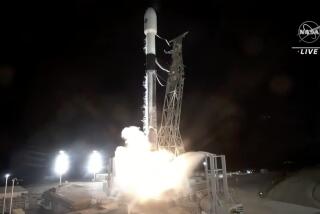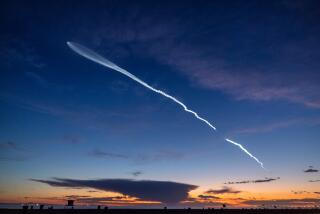Cape Canaveral Celebrates 50 Years of Launches
- Share via
CAPE CANAVERAL, Fla. — Before moon rockets and space shuttles, even before satellites and John Glenn, there was li’l Bumper, a mongrel rocket that rose 50 years ago from the wild Florida marsh.
The launch of this rocket on July 24, 1950, set in motion a race to space that remains rooted at Cape Canaveral.
But the men who poured the cement and laid the cables, who fought off pesky critters and carried off stubborn residents, never dreamed that the craziness--an American upper stage grafted onto a captured German V-2 rocket--would amount to much.
Not in this Godforsaken place, anyway.
“Just one more launch. One more V-2,” figured Dick Jones, retired now at 75, but once the Army master sergeant who helped find the highest, driest spot for the launch pad. The first six Bumpers had soared from the White Sands Proving Ground in New Mexico, where swamps weren’t a problem.
Since Bumper 8’s modest test flight over the Atlantic, an estimated 3,200 missiles and rockets have blasted off from Cape Canaveral, including during the heyday of the 1960s when it temporarily surrendered its name and became Cape Kennedy.
The cape’s busiest years began in the late 1950s, thanks to tests of military weapons and the advent of NASA and human space flights. The 200-plus launches in 1960, for instance, outnumbered launches in 1999 by 7-1.
Norris Gray, 80, the cape’s first fire chief and emergency services officer, is a local authority on those early days. With the cape’s golden anniversary almost here, he is surveying the Bumper launch site.
Deep inside Cape Canaveral Air Force Station, the pad is just a half-mile beyond a 132-year-old lighthouse.
But what remains? The stainless steel trough that caught spilled rocket fuel, the square slab of concrete that held the steel table that Germans had used to launch V-2 missiles--the missiles that bombarded London and Paris during World War II.
No plaques mark the site. “Right here’s where the missile sat,” says Gray, walking over to a gray patch. “How do I know it? I lived here on the pad with it.”
He points out manholes that led to underground power generators, and smaller holes where pond water flowed to cool the pad and wash away fuel. Today the only sounds are the wind and birds and the occasional loudspeaker announcement from modern Atlas rocket pads nearby.
A half-dozen or so Bumper team members will visit the deserted site this weekend and gather again Monday for a model-rocket launching ceremony.
Fifty years ago, a few dozen families lived along the beach north of the pad, and anyone could drive right in. Now only space program workers with proper badges can visit.
Fifty years ago, the black-and-white-striped lighthouse was the lone landmark and Launch Complex 3 the lone pad. Now 35 launch pads dot the landscape, most of them inactive. The lighthouse is shuttered, nothing more than a tourist bus stop.
Jones, the master sergeant, was stunned when he arrived from the Southwest in late 1949. “Somebody must know something that I don’t know,” he muttered to himself. “Why would anybody want us to come here?”
Dry, sandy White Sands was heaven compared with this.
Dozens of rebuilt V-2 rockets, their parts confiscated from Hitler’s Germany at the end of World War II, had been test-fired from the remote desert of New Mexico beginning in 1946. But a couple landed close to a rancher’s cattle, another near a cemetery across the Mexican border.
The fledgling rocket program clearly had to move. The military preferred Southern California, but the Mexican government refused to let rockets fly overhead. That left Cape Canaveral, choice No. 2, with the Atlantic Ocean as the flight path and the West Indies as the tracking stations.
A long flying corridor, sans inhabitants on the ground, was especially useful for the Army’s Project Bumper, which took its name from the “step rocket” approach. The German V-2 bumped up the United States’ WAC Corporal, an unguided rocket used for high-altitude research. No explosives were on board, just scientific instruments.
The first six Bumpers lifted off from White Sands in 1948 and 1949, climbing as high as 244 miles. Trucked to Cape Canaveral, the last two had downrange distance, not altitude, as the goal.
The cape had visitors long before rocketeers arrived. Juan Ponce de Leon landed in 1513 near Cabo de Canaveral, named “Cape of the Cane Fields” by Spanish explorers. Hernando de Soto may have passed through.
In the ensuing years, shipwrecks left Spanish coins and other treasures in the waters offshore. Homer Joe Stewart, 84, a scientific advisor who recommended Cape Canaveral as a launch site, remembers that some colleagues found gold coins during lunch breaks on the beach.
Stewart found the cape “just perfect” for launching long-range missiles and, eventually, for putting spacecraft into orbit. Banana River Naval Air Station provided the base, and the federal government provided much of the neighboring land. Expanding into a rocket-launching site, Stewart and others reasoned, would be easy.
It was hard, though, working in this harsh, humid land.
Workers let some air out of car tires to ease travel on the sandy roads. Soldiers shooed away snakes sunning on the concrete pad. Members of the launch team kept fire extinguishers in their tents to squirt rattlers. The mosquitoes were fierce. “You’d put your arm out and your arm would be black,” Jones recalls.
The team was a motley 100, including U.S. military men, General Electric engineers and technicians, California Institute of Technology researchers and German rocket scientists who surrendered after World War II. They made do.
The painters’ pipe scaffolding served as the launch tower, a utility pole as the hookup for power umbilicals to the 60-foot rocket. Plywood and tar paper formed the launch control center, while two mirrors served as a periscope to look over a 10-foot sand berm.
Chief Gray, a World War II veteran like almost everyone else, applied wartime strategy: “Keep your troops dispersed.” By locating some team members outside in trenches with phones, he and others hoped that the casualties might not be as severe, should the rocket explode.
The locals thought the rocketeers were nuts. The war was over, so why were these guys shooting up rockets? “You ought to get out of that place,” Jones remembers being told again and again. “Everybody was negative.”
Gray recalls how Miss Mona Martin, a shotgun-toting widow, refused to evacuate her home the morning of liftoff. “I hate to do this,” Gray informed her, a quarter-mile from the launch pad. Then he flung Miss Mona over his shoulder and carried her to a van.
Bumper 7 was actually supposed to fly first, on July 19, 1950, a month after the scrub had been leveled for the pad.
After hours of delay, the countdown reached 3-2-1. A dull thud, a puff of smoke, a flash. The rocket remained still. A fuel valve malfunctioned because of moisture in the missile, a problem the White Sands team hadn’t reckoned on.
Bumper 8 moved onto the pad. And at 9:28 a.m. on July 24, it soared.
Journalists were flabbergasted by the smoke, the flame, the roar.
“We kept our glasses on the monster as it entered the clouds and there lost it,” one newspaper reporter wrote. “The rumble diminished gradually to sound like the roar of a freight train in the distance.”
Chief Gray ran from the launch control center and watched Bumper 8 vanish. “Everybody prayed a little bit to themselves, each in their own way. ‘We made it. We did it.’ ”
At 10 miles high, the V-2 began tilting; then the WAC Corporal separated. Destroyed by remote control, the V-2 slammed into the ocean 50 miles offshore. The WAC Corporal continued another 140 miles before it, too, plunged into the sea. It was only a partial success--the WAC Corporal had not performed as planned.
There was no time to party. Bumper 7 had to be put back on the pad and launched and, besides, “everybody was dead tired,” recalls Gray.
Bumper 7 finally soared on July 29. And Project Bumper ended.
Other missiles soon followed: the Lark, Matador, Snark, Bomarc, Redstone, Navaho, Jupiter, Vanguard, Thor, Polaris, Atlas and more. Then manned rockets blasted off: Redstone and Atlas for Project Mercury, Titan for Project Gemini and the colossal Saturn for the Apollo moon program. And then came the space shuttle.
“We’ve done an awful lot,” says Stewart, the Caltech physicist who helped choose Cape Canaveral as America’s spaceport.
“The technology has grown, and the development in physics and microelectronics has made it possible to do things that were almost impossible to consider in the old days.”
More to Read
Sign up for Essential California
The most important California stories and recommendations in your inbox every morning.
You may occasionally receive promotional content from the Los Angeles Times.










